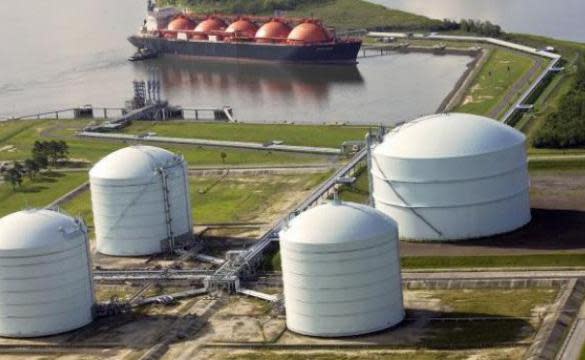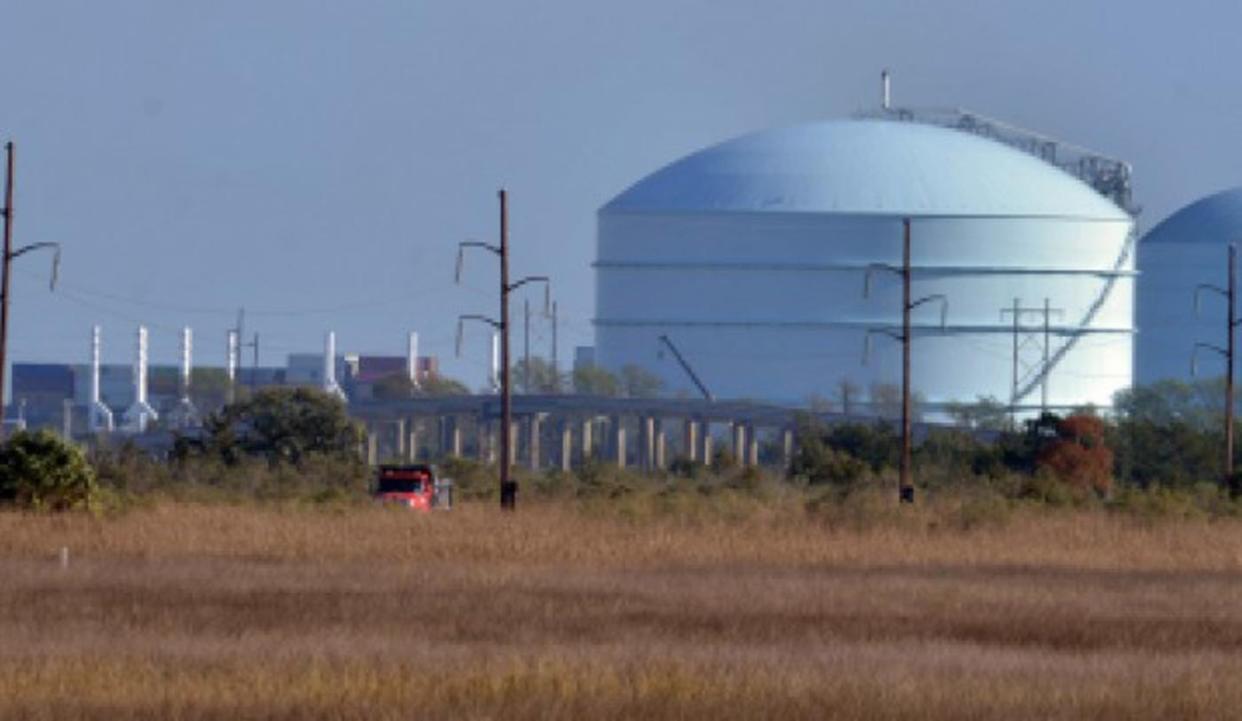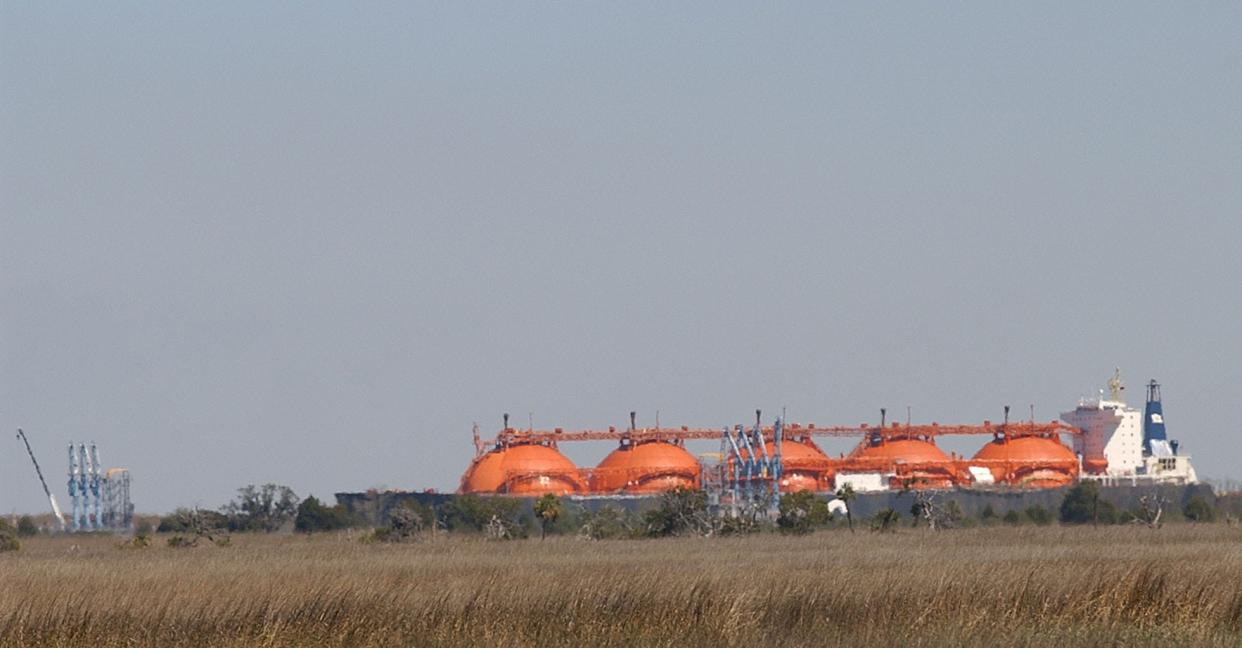Expansion of Savannah natural gas export facility at crux of nation's climate debate

Environmental groups and clean-energy advocates are lining up in opposition to the proposed expansion of natural gas exports from a Savannah facility that also is one of the area’s largest producers of climate-impacting pollution.
Southern LNG, situated on Elba Island in a bend of the Savannah River, is one of just two East Coast exporters of liquified natural gas. The facility is authorized by the U.S. Department of Energy to send more than 300 billion cubic feet of LNG annually on ships to foreign markets.
Some 182.5 billion cubic feet of that total can go to 20 countries with which the U.S. has official free trade agreements. Another 130 billion cubic feet is permitted for non-FTA nations.
Last year, Southern LNG asked federal regulators for approval to significantly increase exports to non-FTA countries.
But on Jan. 26, President Joe Biden announced that the Department of Energy would suspend reviews of such requests while it reassessed the environmental and economic impacts of natural gas, effectively putting Southern LNG’s request on hold indefinitely
“This pause on new LNG approvals sees the climate crisis for what it is: the existential threat of our time,” Biden said in announcing the review. “While MAGA Republicans willfully deny the urgency of the climate crisis, condemning the American people to a dangerous future, my administration will not be complacent. We will not cede to special interests.”
The political tone of Biden’s comment underscores the reality that natural gas has become flashpoint for debate over the future of fossil fuels in Georgia and beyond.
Republican U.S. Rep. Buddy Carter, whose coastal Georgia district includes the Southern LNG facility, argued that the pause “threatens our nation’s global leadership” and plays into the hands of Russian President Vladimir Putin by potentially increasing demand for that country’s natural gas, which he then can use to “weaponize access for political gain.”
The United States has clean, affordable and reliable LNG,” Carter added. “If President Biden is concerned about global emissions, he should increase domestic production, as we have some of the cleanest LNG in the world right here at home.”
More: Elba Island LNG export facility nears completion
A bridge too far?
Domestically, utilities including Georgia Power look at gas and see a reliable bridge as they shutter coal-fired power plants and look to a future when most energy will be generated without the burning of fossil fuels.
That’s because compared to coal, gas generates about half the heat-trapping pollution that causes climate change. And unlike solar panels and wind turbines, gas-fueled facilities can run uninterrupted when the sun’s not shining and there’s no breeze.
However, critics counter that while a shift to natural gas is largely responsible for U.S. carbon emissions falling by more than one-third since 2005, adding fossil fuel generation – even as coal plants are retired – will continue to drive temperatures to a point where the impacts of climate change become catastrophic.
For Georgia, that includes sea-level rise, dangerous heat and extreme rainfall in areas already prone to inland and coastal flooding.
“Rapid expansion of LNG exports like we’ve seen at the Elba terminal accelerate climate risk, make prices for U.S. customers more volatile and strain resources needed to make the clean energy transition,” said Alys Campaigne, climate initiative director for the Southern Environmental Law Center. "We strongly support the Department of Energy taking a close look at the serious climate and economic consequences of LNG.”

Exporter, consumer, polluter
As it pursues a hike in exports, Southern LNG finds itself at the center of energy-related debate – as a mover and user of natural gas, and as one of Chatham County’s largest emitters of climate-impacting pollution.
LNG takes up about 600 times less volume than natural gas in its vapor state, making it ideal for shipping. But liquification is energy intensive because it requires chilling the gas to roughly minus 260 degrees.
For Southern LNG, that process involves hundreds of compressors actually fueled by natural gas.
Top 10 Carbon Polluters in Chatham County by savannahnow.com on Scribd
In 2022 – the latest full year of data available from the EPA – operations at the Elba Island plant led to almost 140 million metric tons of greenhouse gas pollution. Nearly all of that was carbon dioxide, the leading contributor to climate change.
That level of emissions is the equivalent of what would be produced by more than 31,000 U.S. passenger vehicles over the period of a year, according to the EPA.
In Chatham County, only the International Paper Savannah Plant, U.S. Sugar Savannah Refinery and City of Savannah Dean Forest Landfill emit more greenhouse gas pollution.
Houston-based Kinder Morgan Inc., which operates Southern LNG and holds a 25.5% ownership stake in the facility, did not directly address questions about its liquification process.
“Kinder Morgan is committed to public safety, protection of the environment and the responsible operation of our facilities,” company spokeswoman Vicky Oddi wrote in an email. “It is our goal to cooperate with all stakeholders regarding environmental, health and safety issues.”
While the company currently owns an interest in, or operates, about 82,000 miles of pipelines, 139 terminals and 702 billion cubic feet of natural gas storage capacity, Kinder Morgan says its 500 natural gas-powered compressors are its largest source of greenhouse gas emissions.
That’s not likely to change, at least in the near term.
“While electrification is widely favored as a potential means of reducing (greenhouse gas) emissions, we found that electrifying our natural gas-fired compressor fleet would be neither economically feasible nor particularly effective at reducing combined Scope 1 and Scope 2 emissions for us at this time,” CEO Steve Kean noted in the company’s 2022 Environmental, Social and Governance (ESG) Report.
Scope 1 emissions are tied directly to a company’s facilities, while Scope 2 involves pollution produced through the generation of energy used to power operations.
“While a large-scale transformation of our compressor fleet to electric power may not be an option today, we continue to look for other ways to make progress on our emissions reductions,” Kean continued. “We expect that, in time, cost-effective technologies or other solutions for reducing GHG emissions from our compressor fleet will be developed.”
That means in addition to being a major transporter of fossil fuel domestically and internationally, the Southern LNG facility will remain a significant consumer of natural gas, as well.
More: What a $2 billion expansion on Elba Island could mean for one of Chatham’s biggest tax payers
'An open and transparent process'
What’s uncertain is how much liquified natural gas the Savannah facility ultimately will be permitted to send overseas.
The Biden Administration’s pause does not impact current liquid natural gas shipments from eight U.S. export facilities, which averaged 11.6 billion cubic feet per day in 2023. But the review will reevaluate the lifecycle impact of the process.
That includes methane released into the atmosphere when natural gas is extracted through the hydraulic fracturing, or fracking, of shale; and from leaks as it is distributed.
Methane is itself a heat-trapping gas, about 30 times more potent than carbon dioxide, so even small amounts have an outsized effect.
In addition to nearly 135,500 metric tons of carbon dioxide, the Southern LNG facility in Savannah released more than 4,000 metric tons of methane in 2022, according to the EPA. Over time, the climate impact of that amount would be equal to emissions from an average American vehicle driving 287 million miles.
Once dispatched from the liquifying facility, ships transporting LNG produce significant carbon dioxide emissions. And when the shipment reaches foreign docks, the overland transport process – and associated methane leaks – is repeated.
Finally, the burning of the gas sends the highest concentrations of greenhouse gases into the atmosphere.
“We need an open and transparent process for determining how best to assess these critical concerns, Manish Bapna, president and CEO of the Natural Resources Defense Council, said in response to Biden’s announcement. “The public deserves to be heard on how our government decides whether projects are in the public interest.”

John Deem covers climate change and the environment in coastal Georgia. Contact him at jdeem@gannett.com.
This article originally appeared on Savannah Morning News: Biden pauses divisive expansion of Savannah natural gas facility
